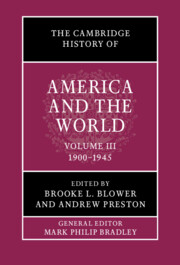Book contents
- The Cambridge History of America and the World
- The Cambridge History of America and the World
- The Cambridge History of America and the World
- Copyright page
- Contents
- Figures
- Maps
- Contributors to Volume III
- General Introduction: What is America and the World?
- Introduction to Volume III
- Part I American Power in the Modern Era
- Part II Competing Perspectives
- 12 Fighting Jim Crow in a World of Empire
- 13 Wilsonianism and Its Critics
- 14 Humanitarianism and US Foreign Assistance
- 15 Women’s Politics in International Context
- 16 The October Revolution and the American Left
- 17 Sexuality and Sexual Politics
- 18 Religious World Views
- 19 Indigenous Sovereignties and Social Movements
- 20 Fascism and Nativism
- Part III The Perils of Interdependence
- Index
12 - Fighting Jim Crow in a World of Empire
from Part II - Competing Perspectives
Published online by Cambridge University Press: 12 November 2021
- The Cambridge History of America and the World
- The Cambridge History of America and the World
- The Cambridge History of America and the World
- Copyright page
- Contents
- Figures
- Maps
- Contributors to Volume III
- General Introduction: What is America and the World?
- Introduction to Volume III
- Part I American Power in the Modern Era
- Part II Competing Perspectives
- 12 Fighting Jim Crow in a World of Empire
- 13 Wilsonianism and Its Critics
- 14 Humanitarianism and US Foreign Assistance
- 15 Women’s Politics in International Context
- 16 The October Revolution and the American Left
- 17 Sexuality and Sexual Politics
- 18 Religious World Views
- 19 Indigenous Sovereignties and Social Movements
- 20 Fascism and Nativism
- Part III The Perils of Interdependence
- Index
Summary
Race was never far from conversations about empire. In 1911 an international collection of ethnologists, social scientists, and reformers gathered at the University of London to discuss the problem of the color line. Had the Universal Races Congress functioned as nothing but a “World Grievance Committee” – to borrow a phrase from the sociologist and National Association for the Advancement of Colored People (NAACP) co-founder W. E. B. Du Bois – it would have served a vital role. Yet for all the value of fostering discussion between “so-called white and so-called coloured people,” as conveners labeled them, the Congress’s greatest contribution came in its intellectual interventions. Speakers like Du Bois and Sioux physician Charles Eastman arrived with cornerstone American legacies of dispossession and chattel slavery weighing heavy on their minds. What scholars now might frame as ravening settler colonialism, Du Bois, Eastman, and others discussed in terms of expansion, independence, development, and disfranchisement. Though the organizers called them “inter-racial problems,” Du Bois recognized the very notion of race as the concept that made these problems all of a piece. He welcomed the conference’s rejection of race as a scientific fact, and of racial differences as immutable or tethered to innate capacity. For too long, he noted, scientific racism had provided cover for “widespread and decisive political action” in service to white supremacy – from “the disfranchisement of American negroes” to “the subjugation of India and the partition of Africa.” For too long, racial discourses had reinforced racialized power.1
- Type
- Chapter
- Information
- The Cambridge History of America and the World , pp. 293 - 314Publisher: Cambridge University PressPrint publication year: 2022

